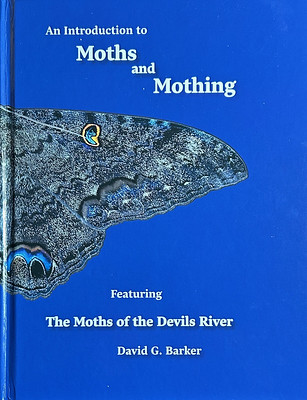
David G. Barker (@ptexis) has just published a gorgeous volume entitled, "An Introduction to Moths and Mothing, Featuring The Moths of the Devils River" (VPI Library, 2023**). I met Dave Barker for the first time several years ago during an iNaturalist bioblitz at Lake Amistad National Recreation Area, not far the Barkers' getaway home on the Devils River in southwest Texas. Based on mutual interests, we immediately struck up a friendship from which I have benefitted disproportionately.
Barker's lifelong interest in snakes, and in particular his fascination with Gray-banded Kingsnakes, lead him to the Devils River many years ago and it was there that an interest in moths was sparked in 2016. Dave is a keen researcher with an eye for detail and that is evidenced in his research on moths and his photographic skills.
An Introduction to Moths and Mothing (IMM) is a slick, well-structured volume with useful information for moth-ers and nature enthusiasts at all levels of interest. Barker's writing style is down-to-earth, matter-of-fact, and very readable. He uses technical terms with facility but is quick to define each for the general reader. The volume has five introductory chapters describing, in order, "All about Moths", "The Basics of Mothing", "Names and Numbers of Moths", "Identifying Moths", and "Photographing Moths". Dave includes a 9-page ecological introduction to the Devils River, one of the most enticing, important, and biologically fascinating watersheds of Texas. These chapters, each of which is well-illustrated with nicely selected images, are packed with invaluable nuggets, but they are, for me, just a tasty appetizer leading to the main moth entrée.
Just over half of IMM is taken up by Dave's beautifully photographed moths from the Devils River. This is eye candy of a caloric richness that will delight the senses of even the most dispassionate nature observer. The 106 plates display 558 species of moths which Dave documented in just a five-year span. Here Dave's photographic skills are on full display. The generously oversized and well-cropped images show moths in natural poses--not uncommonly with multiple images of variable species. Each image is labeled with the scientific name and the species' "Hodges Number" (i.e., from the Checklist of Lepidoptera of North American). The species are displayed in taxonomic order by Hodges Numbers. There is no biased "selection" of species here; the micros and the macros, the gaudy and the not-so-gaudy are all illustrated. I applaud Dave for this comprehensive presentation. Certainly there will be many more moths to be discovered and documented in this--and every--corner of Texas, but Barker has offered a gorgeous guide to the vast majority of what is known from the region. Importantly, the diverse set of species included by Barker harbors many widespread Texas taxa along with a mouth-watering display of the very special moth fauna which characterizes Southwest Texas.
There are essentially no identification notes accompanying the images but this is explicitly a "photographic guide" to the species and it serves that purpose well. The reader can thereafter consult any of our commonly used resources such as iNaturalist, Moth Photographers' Group, and BugGuide, or the recent Leckie & Beadle field guide (Southeastern U.S., Peterson Field Guide series, Houghton Mifflin Harcourt) for ID help. Moreover, because of the geographic focus of IMM, this contribution offers a critical supplement for moth-ers in a larger swath of Texas to what is found in the latter field guide.
The volume concludes with a set of appendices covering a species list, useful references, and a few other tidbits. Perhaps my only minor disappointment with IMM is its lack of an alphabetic index to the moth species included; Appendix 1 "indexes" all the species, but it is not so much an index as just a list of the species, plate by plate, in Hodges order. Appendix 1 contains common names of those moths for which such names are in regular use.
Did I mention Barker's photographic skills? These are emphatically on display in a set of distractingly beautiful "moth pattern images" on interleaves and facing pages separating chapters. Dave has artfully created the several pages by carefully crafting kaleidoscopic compositions of repeated, small, cropped bits of moth wings. There are 15 such pages scattered from cover to cover and--Spoiler Alert--the identities of the moths from which he created the art are listed in Appendix 3. I challenge the reader to take the "quiz" and try to recognize and name the moth contributing to each page before consulting the list of species!
Simply put, this is a must-have volume for anyone interested in Texas moths and, with its informative introductory chapters, it will have a much wider utility for nature lovers in broader regions.
**The volume can be ordered online at: https://vpi.com/galleries/moths-2024.
Disclosure: I was the happy recipient of an early pre-distribution copy of this volume. I thank Dave Barker for that kindness.






































